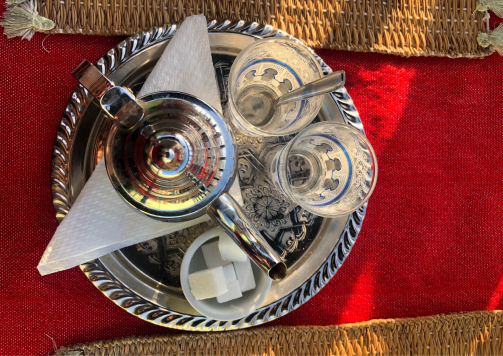Travel: Moroccan Food

The pure excitement of tasting and indulging in another culture’s cuisine is one of the most exciting things whilst away travelling or holidaying. That’s why I’m going to tell you all about the things I tried and tasted, many times on my Christmas trip to Morocco.
Bread
Spend just one day in Morocco and it will become evident how important bread is in Moroccan cuisine. A staple food in their diet, consumed with pretty much every meal, as an accompaniment, to a tagine or couscous, and as a spoon. There are many different types of bread but the most common is the khobz, a disc-shaped type of crusty white bread. Fresh bread is made and baked daily and sold on the streets to everyone, almost all locals were at some point carrying a bag of bread home!
Msemen
If you like pancakes, this one is for you. A think flaky flatbread with multiple layers, popular for breakfast and street food in Morocco. Msemen is made with a dough consisting of flour, durum wheat semolina, soft butter, dry yeast, salt, sugar, and water.
Eggs!
No, please no, I never want to eat another egg again. I had this same palette opinion before when I visited Colombia, I ate eggs every day for breakfast and I couldn’t take it anymore. So much so that even now too many eggs make me feel a bit queasy. So, when an omelette and boiled eggs were presented to me every morning in Morocco I smiled faintly and swallowed down my previous experience.
Kefta
My favourite and worth mentioning first, obviously! I’ve always been one for loving a meatball and let’s just say that hasn’t changed one bit. A kefta tagine is small beef or lamb meatballs covered in a rich zesty tomato sauce. It’s also served with a poached egg and cooked traditionally in a tagine where it is slowed cooked. There is no fast food in Morocco, this is why the meatballs are so small so they can cook thoroughly in an acceptable time.
Tagines
Ah the tagine, a dish so well connected with Moroccan just the thought of Morocco makes you think of tagines. The word tagine stems from the Berber word tajin, meaning “shallow earthen pot”. The Tagine is the earthenware cookware used in Moroccan cooking as well as the dish. The tagine’s unique cone-like shape is designed to trap the steam, reducing the amount of water needed to slow cook and tenderize meat or vegetables, fantastic in a country where drought is a serious and sadly ever-pressing climate-related issue. A Tagine is cooked over charcoal or wood fire.
Couscous
A main ingredient and dish in Morocco but only traditionally cooked served and eaten on a Friday. Whilst most of the rest of the world is finishing up on a Friday, it is typically a quieter day in Morocco. Men visit the hammam, prior to Friday midday prayers, whilst women are at home preparing the couscous, a dish that takes hours – no instant couscous here. After Friday prayers the whole family gather around a platter of couscous served with 7 vegetables – eggplant, zucchini, carrots, parsnips, pumpkin, tomato and a bit of cabbage. Oh and not forgetting the Tfaya, a sweet sauce made with caramelized onions, raisins, cinnamon, and honey – absolutely and truly delicious!
Mint Tea
Cup of tea love? Okay, a tad British but the Moroccans do love their tea too! Just they like a slightly more natural mint tea. Drank daily, hourly if possible and always accompanied by blocks, yes really, of sugar, optional to add of course, and if you saw some of the teeth we saw you’d say no to that sugar lump! Mint teas vary from just mint to mint and other herbs but it is THE drink of Morocco because it is the drink of friendship and hospitality. Drank as a welcome to guests, with friends to celebrate, after food to help digestion, in the morning instead of coffee, literally anytime. Tea doesn’t grow in Morocco though so it’s imported along with the mint. Alas it’s very tasty and usually the cheapest drink on a menu – stick to what the locals drink.
